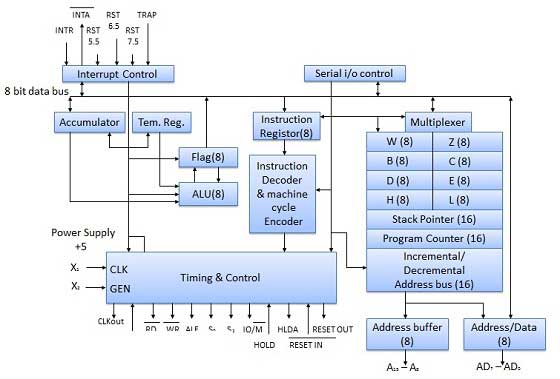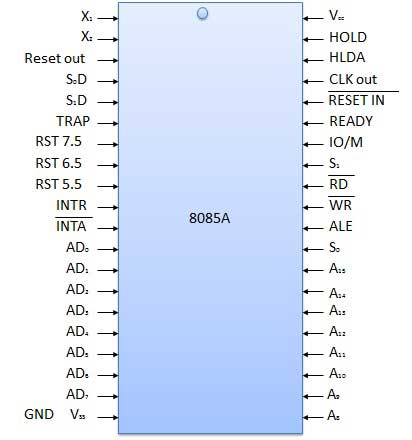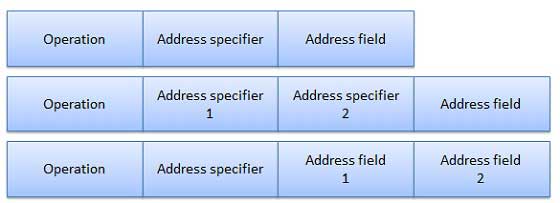- CPU (1)
- MySQL的体系结构
- MySQL的体系结构(1)
- CPU - 任何代码示例
- Docker-体系结构(1)
- Docker体系结构
- Docker-体系结构
- Docker体系结构(1)
- Angular 7体系结构
- TensorFlow的体系结构(1)
- TensorFlow的体系结构
- DBMS体系结构
- DBMS体系结构(1)
- DBMS-体系结构(1)
- DBMS-体系结构
- JavaFX-体系结构(1)
- JavaFX体系结构
- JavaFX-体系结构
- JavaFX体系结构(1)
- CodeIgniter体系结构(1)
- CodeIgniter体系结构
- 什么是.NET 3层体系结构?(1)
- 什么是.NET 3层体系结构?
- Magento 2的体系结构(1)
- Magento 2的体系结构
- Tableau体系结构(1)
- Tableau体系结构
- Cassandra体系结构(1)
- Cassandra体系结构
📅 最后修改于: 2021-01-12 04:58:18 🧑 作者: Mango
微处理单元是传统计算机中使用的中央处理单元(CPU)的同义词。微处理器(MPU)充当执行以下任务的设备或一组设备。
- 与外围设备通讯
- 提供定时信号
- 直接数据流
- 执行内存中的指令指定的计算机任务
8085微处理器
8085微处理器是8位通用微处理器,能够寻址64k的存储器。该处理器有40个引脚,需要+5 V单电源和3 MHz单相时钟。
框图

ALU
ALU执行微处理器的计算函数。它包括累加器,临时寄存器,算术和逻辑电路以及五个标志。结果存储在累加器和标志中。
框图

累加器
它是8位寄存器,是ALU的一部分。该寄存器用于存储8位数据以及执行算术和逻辑运算。操作结果存储在累加器中。
图表

标志
标志是可编程的。它们可以通过使用指令来存储和传输来自寄存器的数据。 ALU包括五个触发器,可根据累加器和其他寄存器中的数据条件进行设置和复位。
-
S(符号)标志-执行算术运算后,如果结果的位D 7为1,则设置符号标志。用于签名号码。在给定的字节中,如果D 7为1表示负数。如果为零,则表示为正数。
-
Z(零)标志-如果ALU运算结果为0,则置零标志。
-
AC(辅助进位)标志-在算术运算中,当数字D3产生进位并传递到数字D 4时,设置AC标志。该标志仅在内部BCD操作中使用。
-
P(奇偶校验)标志-算术或逻辑运算后,如果结果的偶数为1,则设置该标志。如果奇数为1,则重置标志。
-
C(进位)标志-如果算术运算结果为进位,则设置进位标志,否则将其复位。
注册部分
它基本上是一种存储设备,并通过使用指令从寄存器传输数据。
-
堆栈指针(SP) -堆栈指针也是一个16位寄存器,用作内存指针。它指向读/写存储器中称为堆栈的存储器位置。在程序执行之间,有时数据要存储在堆栈中。堆栈的开始是通过在堆栈指针中加载一个16位地址来定义的。
-
程序计数器(PC) -此16位寄存器处理第四次操作以对指令的执行进行排序。该寄存器也是一个内存指针。内存位置有16位地址。用于存储执行地址。程序计数器的函数是指向要从其下一个字节取回的存储器地址。
-
存储寄存器-这些寄存器在程序执行期间存储8位数据。这些寄存器被标识为B,C,D,E,H,L。它们可以组合为寄存器对BC,DE和HL,以执行一些16位操作。
时间和控制科
该单元负责按照时钟脉冲同步微处理器的操作,并产生控制信号,这些信号对于微处理器与外围设备之间的顺利通信是必需的。 RD条和WR条信号是同步脉冲,指示数据在数据总线上是否可用。控制单元负责控制微处理器,内存和外围设备之间的数据流。
PIN图

所有信号可分为六类
| S.N. | Group | Description |
|---|---|---|
| 1 | Address bus |
The 8085 microprocessor has 8 signal line, A15 – A8 which are uni directional and used as a high order address bus. |
| 2 | Data bus |
The signal line AD7 – AD0 are bi-directional for dual purpose. They are used as low order address bus as well as data bus. |
| 3 | Control signal and Status signal |
Control Signal RD bar − It is a read control signal (active low). If it is active then memory read the data. WR bar − It is write control signal (active low). It is active when written into selected memory. Status signal ALU (Address Latch Enable) − When ALU is high. 8085 microprocessor use address bus. When ALU is low. 8085 microprocessor is use data bus. IO/M bar − This is a status signal used to differentiate between i/o and memory operations. When it is high, it indicate an i/o operation and when it is low, it indicate memory operation. S1 and S0 − These status signals, similar to i/o and memory bar, can identify various operations, but they are rarely used in small system. |
| 4 | Power supply and frequency signal |
Vcc − +5v power supply. Vss − ground reference. X, X − A crystal is connected at these two pins. The frequency is internally divided by two operate system at 3-MHz, the crystal should have a frequency of 6-MHz. CLK out − This signal can be used as the system clock for other devices. |
| 5 | Externally initiated signal |
INTR (i/p) − Interrupt request. INTA bar (o/p) − It is used as acknowledge interrupt. TRAP (i/p) − This is non maskable interrupt and has highest priority. HOLD (i/p) − It is used to hold the executing program. HLDA (o/p) − Hold acknowledge. READY (i/p) − This signal is used to delay the microprocessor read or write cycle until a slow responding peripheral is ready to accept or send data. RESET IN bar − When the signal on this pin goes low, the program counter is set to zero, the bus are tri-stated, & MPU is reset. RESET OUT − This signal indicate that MPU is being reset. The signal can be used to reset other devices. RST 7.5, RST 6.5, RST 5.5 (Request interrupt) − It is used to transfer the program control to specific memory location. They have higher priority than INTR interrupt. |
| 6 | Serial I/O ports |
The 8085 microprocessor has two signals to implement the serial transmission serial input data and serial output data. |
指令格式
每个指令由计算机中的一系列位表示。该指令分为称为字段的位组。指令的表达方式称为指令格式。它通常以矩形框的形式表示。指令格式可以是以下类型。
可变指令格式
这些是指令长度根据操作码和地址说明符而变化的指令格式。例如,VAX指令在1到53个字节之间变化,而X86指令在1到17个字节之间变化。
格式

优点
这些格式具有良好的代码密度。
退税
这些指令格式很难解码和流水线化。
固定指令格式
在这种指令格式中,所有指令的大小相同。例如,MIPS,Power PC,Alpha,ARM。
格式

优点
它们易于解码和流水线。
退税
它们的代码密度不好。
混合指令格式
在这种指令格式中,我们有由操作码指定的多种格式长度。例如,IBM 360/70,MIPS 16,Thumb。
格式

优点
这些类型的代码密度和指令之间的这些折衷非常容易解码。
寻址方式
寻址模式提供了用于访问给定数据到处理器的地址的不同方式。操作的数据存储在存储单元中,每条指令都需要某些数据才能对其进行操作。有多种技术可以指定数据地址。这些技术称为寻址模式。
-
直接寻址模式-在直接寻址模式中,操作数的地址在指令中给出,并且数据在指令中提供的存储位置中可用。我们将这些数据移动到所需位置。
-
间接寻址模式-在间接寻址模式中,指令指定包含操作数地址的寄存器。内部RAM和外部RAM均可通过间接寻址模式访问。
-
立即寻址模式-在立即寻址模式中,直接数据在操作数中给出,该数据在累加器中移动。非常快。
-
相对寻址模式-在相对地址模式下,有效地址由索引模式通过使用程序计数器代替通用处理器寄存器来确定。此模式称为相对地址模式。
-
索引寻址模式-在索引地址模式下,通过将内容值添加到寄存器的内容来生成操作数的有效地址。此模式称为索引地址模式。